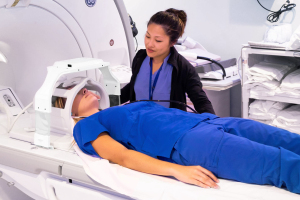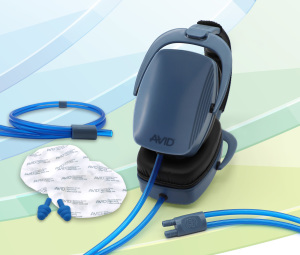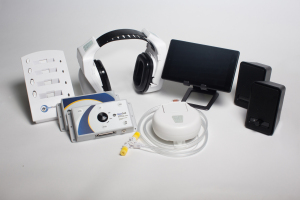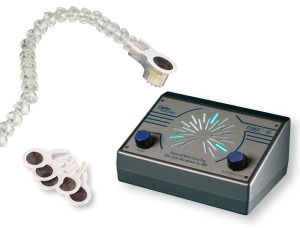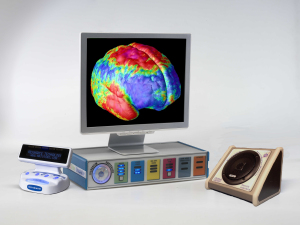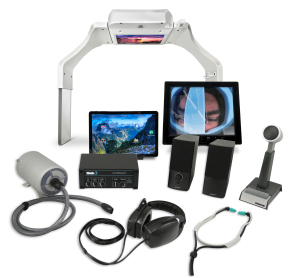A better MR experience
September 07, 2020
by Valerie Dimond, Contributing Reporter
Fear, anxiety, claustrophobia — or just a general feeling of unease — is what many patients undergoing an MR procedure experience. The providers and end users of MR technology are well aware of the challenges, not only from a patient satisfaction and comfort perspective, but how patient experience impacts clinical and financial outcomes.
While there’s no substitute for an engaging and empathetic clinical staff, the actual experience of undergoing a scan can be difficult no matter how supportive the MR suite employees are.
“The technologist is the first line of defense against bad MR experiences,” said Paul E. Bullwinkel, president of Avotec, an MR accessory provider. Yet, it’s not easy to fully grasp what it’s like to be inside an MR bore unless you’ve been there. “Most care providers, radiologists, and technologists, are not required to undergo an MR exam as part of their training; they do not have a personal experience with the inherent difficulties of undergoing an MR exam.”
Fortunately, MR technology is advancing dramatically with equipment features designed to transport patients to other atmospheres, complete with soothing or engaging sounds and landscapes that help reduce the unpleasant experience without sacrificing precision or throughput.
“A patient comfort system can reduce or eliminate the time spent trying to talk a patient through an MR procedure, a process that can disrupt the whole day’s schedule,” said Bullwinkel. “And if a re-exam can be prevented, the potential cost savings may be substantial, because re-examination might not be reimbursed by the insurance company; and in a competitive and socially linked environment, sites that offer patient comfort solutions that lead to less stressful exams may be the ones chosen to fulfill future exam prescription.”
Bullwinkel and other suppliers discussed in detail the technologies their companies are offering to improve the MR experience.
Delightful diversions
Avotec’s new SV-6060 HDMI MR-compatible projector operates anywhere inside an MR room to transform the bore into an environment that appeals to both children and adults. “What the patient used to see as a grey featureless tunnel can now look like a magical underwater video,” said Bullwinkel. “And when combined with the Silent Scan audio system, the MR exam can be transformed into a stress-free and comforting experience.”
Avotec’s Silent Scan system offers a reliable, full-duplex communication pathway to ensure consistent, quality communication between patient and provider. Plus, Avotec’s systems have multiple visual systems and headset types that can be used on all head coils.
PDC’s Caring MR Suite also has new features that can push patient satisfaction scores up — and anesthesia/sedation rates down. The wireless portable video display for in-bore viewing is completely cordless, with no cables, and no need for an RF filter or electrician to install. An improved user interface and control system now has a variety of software features, including a new texting feature to give patients and technologists another way to communicate during exams. The software also enables the creation of changeable, gradient color themes.
“There are many gradients that come pre-loaded in the system, but the real beauty is the ability to quickly and easily create custom gradients that can be saved as a standard selection,” said chief sales officer Michael W. Hemmerly. “The new software also has the ability to add a countdown timer overlaid on the video displays, useful for things like breath holds and giving a visualization of how much longer the patient has for the current sequence.”
The CinemaVision audio/video system from Resonance Technology Inc. may be another solution for reducing claustrophobia without the use of sedation, with virtual reality goggles that can change the atmosphere inside the bore.
“The important part is when the patient is inside the tunnel of the MR and gets anxious and vry frightened,” said sales representative Olivia Shayesteh. “By wearing the virtual reality goggles, the patients are no longer aware of their surroundings. Patients feel as if they are in the movie theater, watching a cinema. All they see is a giant 62-inch screen and enjoy stunning sight and sound experience. Resonance Technology Inc. was the first developer to manufacture video displays which were able to function completely inside the magnet bore.”
Hear, hear!
Taking audio to new level is NeoCoil, a company that has developed cutting-edge wireless technology for use during an MR procedure that, unlike many other MR headset options, works without the use of earplugs. Steven Wolff, radiologist and owner, describes his company’s newest offering, an over-the-ear wireless patient communication and entertainment audio system called Sentinel.
“It protects the patient’s hearing with 29 dB of noise reduction, allowing it to be used without additional earplugs at noise levels up to 128 dB,” Wolff said. “Many other over-the-ear headsets have substantially less sound attenuation and require the use of earplugs routinely.”
Wolff says many MR headsets still operate on antiquated technology developed a long time ago for the airline industry. “With this pneumatic technology, sound travels several feet within hollow tubes that are attached to the headset. As you might imagine, sound quality is poor, and it is even poorer still if the patient is also wearing earplugs,” he said, adding that even highly rated earplugs must be inserted properly and fill the ear canal to offer maximum protection, although most patients find this uncomfortable and fail to get or maintain a proper fit.
“Sentinel’s speaker fits in the cup of the headset, right next to the patient’s ear, so the sound quality is great,” said Wolff. “The National Institute for Occupational Safety and Health suggests that in real-life practice, over-the-ear headsets should be considered to have a 50% higher noise reduction rating than foam plugs even when they are labelled with the same noise reduction rating.”
The Sentinel headset’s music source also pauses automatically when the technologist uses push-to-talk or when the MR scanner gives pre-recorded breathing instructions to the patient.
Also on the audio front is Optoacoustics, which is now working on a new release of its OptoACTIVE active noise-cancelling MR headphones designed to help patients remain calm and motionless during the entire scan.
“We managed to eliminate the EPI noise learning mode; this means that a patient inside the MR will not be exposed to any scanner noise whatsoever before the OptoACTIVE starts actively cancelling noise,” explained Bob Rosenbaum, strategic marketing. “With OptoACTIVE, it's even possible for a patient to enjoy full-range, high-fidelity audio — an experience that conventional pneumatic headphones cannot provide.”
The company’s FOMRI, a noise-reducing microphone, is also becoming the “de facto standard for crisp, clear speech recording in MR research environments,” according to Rosenbaum. “Using the FOMRI microphone, a radiologist can easily hear even a slight whisper by the patient and immediately understand their condition — much better than having them squeeze a handpump.”
Another innovation is the wireless IMROC system, designed for interventional MR environments with multichannel noise-cancelling MR headsets that can be used by up to eight people simultaneously, including the patient. “Everyone just talks normally, without the need to shout above the EPI noise or signal each other with their hands,” said Rosenbaum. “Being able to easily communicate in the iMRI suite changes the game for them completely.”
The MR Safe Headphone from AVID Products Inc. also focuses on patient safety, comfort, and experience to improve the rate of successful scans. “We understood the importance of obtaining frontline input during the process and partnered with a leading MR facility during development, including clinical trials to get critical feedback from technologists and patients,” said Michelle Turcotte, senior visual designer at AVID. “The AVID MR Safe Headphones block out 30% more noise than other rated products in their class and offer our superior sound, plus acoustic tubing that provides the patient with improved sound clarity, making it easy to hear technologists' instructions and listen to their favorite music playback during the scanning process.”
And when it comes to earplugs, AVID’s tree-style silicone earplugs purportedly provide improved noise blocking and comfort over typical foam earplugs. “This style avoids having to pinch the plugs prior to ear insertion and then waiting for them to expand,” said Tarcotte. AVID offers adjustable headbands, tube sleeves to assist with tube placement, and a reinforced ear cup connection with comfortable, dual-layer padding.
MRIAudio is another company on the forefront of MR technology. One of its latest developments is its MRIview, a video display that the patient uses during the scan, which includes a patient monitoring camera. “At one of our pilot sites we [placed] the MRIview on a patient under anesthesia and the anesthesiologist made a point to make sure everyone knew how much he wanted this for all scans,” said John Hornbrook, customer service manager, MRIaudio. “The patients are still getting an earplug or an earmuff, but now with our system, you can listen to music, or a podcast or an audiobook. Having that distraction, as minor as it may seem, can help to relieve anxieties and stress during the scan.”
The technology, which has no compatibility issues, has proven to make the entire scanning process easier for both the provider and the patient.
“The patients are able to distract themselves from the noise from the machine, the stress of getting a scan, and what that scan can reveal about you,” Hornbrook said. “This, in turn, allows the technologist to scan patients without having to stop and give the patient a moment to relax. It also allows the technologist to speak directly to the patient through the headset the patient is wearing so instructions are clear and the technologist can communicate with the patient on what to expect and how long it is going to take to complete the next scan.
“We get two types of feedback,” Hornbrook continued. “The first is that patients enjoy the system and it helps them with staying in the scanner for longer periods of time. The other feedback we get is how much the technologist likes the system because it is easy to use and now technologists can listen to music at the control computer providing them a form of entertainment.”
While there’s no substitute for an engaging and empathetic clinical staff, the actual experience of undergoing a scan can be difficult no matter how supportive the MR suite employees are.
“The technologist is the first line of defense against bad MR experiences,” said Paul E. Bullwinkel, president of Avotec, an MR accessory provider. Yet, it’s not easy to fully grasp what it’s like to be inside an MR bore unless you’ve been there. “Most care providers, radiologists, and technologists, are not required to undergo an MR exam as part of their training; they do not have a personal experience with the inherent difficulties of undergoing an MR exam.”
Fortunately, MR technology is advancing dramatically with equipment features designed to transport patients to other atmospheres, complete with soothing or engaging sounds and landscapes that help reduce the unpleasant experience without sacrificing precision or throughput.
“A patient comfort system can reduce or eliminate the time spent trying to talk a patient through an MR procedure, a process that can disrupt the whole day’s schedule,” said Bullwinkel. “And if a re-exam can be prevented, the potential cost savings may be substantial, because re-examination might not be reimbursed by the insurance company; and in a competitive and socially linked environment, sites that offer patient comfort solutions that lead to less stressful exams may be the ones chosen to fulfill future exam prescription.”
Bullwinkel and other suppliers discussed in detail the technologies their companies are offering to improve the MR experience.
Delightful diversions
Avotec’s new SV-6060 HDMI MR-compatible projector operates anywhere inside an MR room to transform the bore into an environment that appeals to both children and adults. “What the patient used to see as a grey featureless tunnel can now look like a magical underwater video,” said Bullwinkel. “And when combined with the Silent Scan audio system, the MR exam can be transformed into a stress-free and comforting experience.”
Avotec’s Silent Scan system offers a reliable, full-duplex communication pathway to ensure consistent, quality communication between patient and provider. Plus, Avotec’s systems have multiple visual systems and headset types that can be used on all head coils.
PDC’s Caring MR Suite also has new features that can push patient satisfaction scores up — and anesthesia/sedation rates down. The wireless portable video display for in-bore viewing is completely cordless, with no cables, and no need for an RF filter or electrician to install. An improved user interface and control system now has a variety of software features, including a new texting feature to give patients and technologists another way to communicate during exams. The software also enables the creation of changeable, gradient color themes.
“There are many gradients that come pre-loaded in the system, but the real beauty is the ability to quickly and easily create custom gradients that can be saved as a standard selection,” said chief sales officer Michael W. Hemmerly. “The new software also has the ability to add a countdown timer overlaid on the video displays, useful for things like breath holds and giving a visualization of how much longer the patient has for the current sequence.”
The CinemaVision audio/video system from Resonance Technology Inc. may be another solution for reducing claustrophobia without the use of sedation, with virtual reality goggles that can change the atmosphere inside the bore.
“The important part is when the patient is inside the tunnel of the MR and gets anxious and vry frightened,” said sales representative Olivia Shayesteh. “By wearing the virtual reality goggles, the patients are no longer aware of their surroundings. Patients feel as if they are in the movie theater, watching a cinema. All they see is a giant 62-inch screen and enjoy stunning sight and sound experience. Resonance Technology Inc. was the first developer to manufacture video displays which were able to function completely inside the magnet bore.”
Hear, hear!
Taking audio to new level is NeoCoil, a company that has developed cutting-edge wireless technology for use during an MR procedure that, unlike many other MR headset options, works without the use of earplugs. Steven Wolff, radiologist and owner, describes his company’s newest offering, an over-the-ear wireless patient communication and entertainment audio system called Sentinel.
“It protects the patient’s hearing with 29 dB of noise reduction, allowing it to be used without additional earplugs at noise levels up to 128 dB,” Wolff said. “Many other over-the-ear headsets have substantially less sound attenuation and require the use of earplugs routinely.”
Wolff says many MR headsets still operate on antiquated technology developed a long time ago for the airline industry. “With this pneumatic technology, sound travels several feet within hollow tubes that are attached to the headset. As you might imagine, sound quality is poor, and it is even poorer still if the patient is also wearing earplugs,” he said, adding that even highly rated earplugs must be inserted properly and fill the ear canal to offer maximum protection, although most patients find this uncomfortable and fail to get or maintain a proper fit.
“Sentinel’s speaker fits in the cup of the headset, right next to the patient’s ear, so the sound quality is great,” said Wolff. “The National Institute for Occupational Safety and Health suggests that in real-life practice, over-the-ear headsets should be considered to have a 50% higher noise reduction rating than foam plugs even when they are labelled with the same noise reduction rating.”
The Sentinel headset’s music source also pauses automatically when the technologist uses push-to-talk or when the MR scanner gives pre-recorded breathing instructions to the patient.
Also on the audio front is Optoacoustics, which is now working on a new release of its OptoACTIVE active noise-cancelling MR headphones designed to help patients remain calm and motionless during the entire scan.
“We managed to eliminate the EPI noise learning mode; this means that a patient inside the MR will not be exposed to any scanner noise whatsoever before the OptoACTIVE starts actively cancelling noise,” explained Bob Rosenbaum, strategic marketing. “With OptoACTIVE, it's even possible for a patient to enjoy full-range, high-fidelity audio — an experience that conventional pneumatic headphones cannot provide.”
The company’s FOMRI, a noise-reducing microphone, is also becoming the “de facto standard for crisp, clear speech recording in MR research environments,” according to Rosenbaum. “Using the FOMRI microphone, a radiologist can easily hear even a slight whisper by the patient and immediately understand their condition — much better than having them squeeze a handpump.”
Another innovation is the wireless IMROC system, designed for interventional MR environments with multichannel noise-cancelling MR headsets that can be used by up to eight people simultaneously, including the patient. “Everyone just talks normally, without the need to shout above the EPI noise or signal each other with their hands,” said Rosenbaum. “Being able to easily communicate in the iMRI suite changes the game for them completely.”
The MR Safe Headphone from AVID Products Inc. also focuses on patient safety, comfort, and experience to improve the rate of successful scans. “We understood the importance of obtaining frontline input during the process and partnered with a leading MR facility during development, including clinical trials to get critical feedback from technologists and patients,” said Michelle Turcotte, senior visual designer at AVID. “The AVID MR Safe Headphones block out 30% more noise than other rated products in their class and offer our superior sound, plus acoustic tubing that provides the patient with improved sound clarity, making it easy to hear technologists' instructions and listen to their favorite music playback during the scanning process.”
And when it comes to earplugs, AVID’s tree-style silicone earplugs purportedly provide improved noise blocking and comfort over typical foam earplugs. “This style avoids having to pinch the plugs prior to ear insertion and then waiting for them to expand,” said Tarcotte. AVID offers adjustable headbands, tube sleeves to assist with tube placement, and a reinforced ear cup connection with comfortable, dual-layer padding.
MRIAudio is another company on the forefront of MR technology. One of its latest developments is its MRIview, a video display that the patient uses during the scan, which includes a patient monitoring camera. “At one of our pilot sites we [placed] the MRIview on a patient under anesthesia and the anesthesiologist made a point to make sure everyone knew how much he wanted this for all scans,” said John Hornbrook, customer service manager, MRIaudio. “The patients are still getting an earplug or an earmuff, but now with our system, you can listen to music, or a podcast or an audiobook. Having that distraction, as minor as it may seem, can help to relieve anxieties and stress during the scan.”
The technology, which has no compatibility issues, has proven to make the entire scanning process easier for both the provider and the patient.
“The patients are able to distract themselves from the noise from the machine, the stress of getting a scan, and what that scan can reveal about you,” Hornbrook said. “This, in turn, allows the technologist to scan patients without having to stop and give the patient a moment to relax. It also allows the technologist to speak directly to the patient through the headset the patient is wearing so instructions are clear and the technologist can communicate with the patient on what to expect and how long it is going to take to complete the next scan.
“We get two types of feedback,” Hornbrook continued. “The first is that patients enjoy the system and it helps them with staying in the scanner for longer periods of time. The other feedback we get is how much the technologist likes the system because it is easy to use and now technologists can listen to music at the control computer providing them a form of entertainment.”

